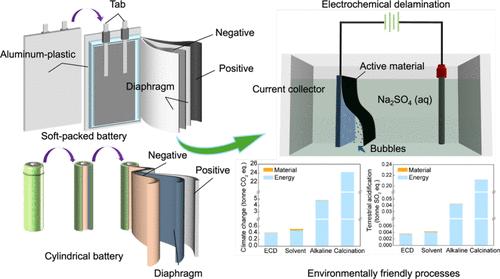Ultrafast Material Separation by Electrochemical Delamination for Spent Lithium-Ion Batteries Recycling
IF 7.3
1区 化学
Q1 CHEMISTRY, MULTIDISCIPLINARY
引用次数: 0
Abstract
The rapid growth of lithium-ion batteries in personal electronics and electric vehicles is leading to a substantial increase in end-of-life battery waste. Recycling these batteries is essential to closing the materials loop for sustainable energy systems. A crucial step in battery recycling is the separation of active materials from current collectors. However, current processes often require extensive use of acids, bases, or solvents, which intensifies environmental impacts. Here, we report an electrochemical delamination process for efficient and ultrafast separation of battery materials. By applying a mild voltage, gas bubbles form between the current collectors and active materials, facilitating their rapid separation with a separation efficiency of ∼100% and a metal recovery yield of >97%. Notably, no aluminum impurities are introduced into the recovered cathode materials. Mechanistic studies reveal that the superior hydrogen evolution capability of the current collectors, compared to the cathode and anode materials, drives the mechanical separation. This electrochemical delamination technique is versatile for various battery chemistries, as demonstrated by the successful separation of LiMn2O4, LiFePO4, and LiNiCoMnO2 cathodes from aluminum, as well as separating graphite anode from copper. Life-cycle assessment and techno-economic analysis indicate that this process can reduce carbon emissions by 23–98% and operating costs by 28–98% compared to current methods, underscoring its potential for real-world implementation.

废锂离子电池回收中电化学分层超快材料分离
锂离子电池在个人电子产品和电动汽车中的快速增长,导致了报废电池浪费的大幅增加。回收这些电池对于闭合可持续能源系统的材料循环至关重要。电池回收的关键步骤是将活性物质从电流收集器中分离出来。然而,目前的工艺通常需要大量使用酸、碱或溶剂,这加剧了对环境的影响。在这里,我们报道了一种电化学脱层工艺,用于电池材料的高效和超快分离。通过施加一个温和的电压,在集热器和活性材料之间形成气泡,促进它们的快速分离,分离效率为100%,金属回收率为97%。值得注意的是,回收的正极材料中没有引入铝杂质。机理研究表明,与正极材料和负极材料相比,集流器具有更强的析氢能力,从而推动了机械分离。这种电化学分层技术适用于各种电池化学性质,如成功地从铝中分离出LiMn2O4、LiFePO4和LiNiCoMnO2阴极,以及从铜中分离出石墨阳极。生命周期评估和技术经济分析表明,与目前的方法相比,该工艺可以减少23-98%的碳排放量和28-98%的运营成本,强调了其在现实世界中的应用潜力。
本文章由计算机程序翻译,如有差异,请以英文原文为准。
求助全文
约1分钟内获得全文
求助全文
来源期刊

ACS Sustainable Chemistry & Engineering
CHEMISTRY, MULTIDISCIPLINARY-ENGINEERING, CHEMICAL
CiteScore
13.80
自引率
4.80%
发文量
1470
审稿时长
1.7 months
期刊介绍:
ACS Sustainable Chemistry & Engineering is a prestigious weekly peer-reviewed scientific journal published by the American Chemical Society. Dedicated to advancing the principles of green chemistry and green engineering, it covers a wide array of research topics including green chemistry, green engineering, biomass, alternative energy, and life cycle assessment.
The journal welcomes submissions in various formats, including Letters, Articles, Features, and Perspectives (Reviews), that address the challenges of sustainability in the chemical enterprise and contribute to the advancement of sustainable practices. Join us in shaping the future of sustainable chemistry and engineering.
 求助内容:
求助内容: 应助结果提醒方式:
应助结果提醒方式:


